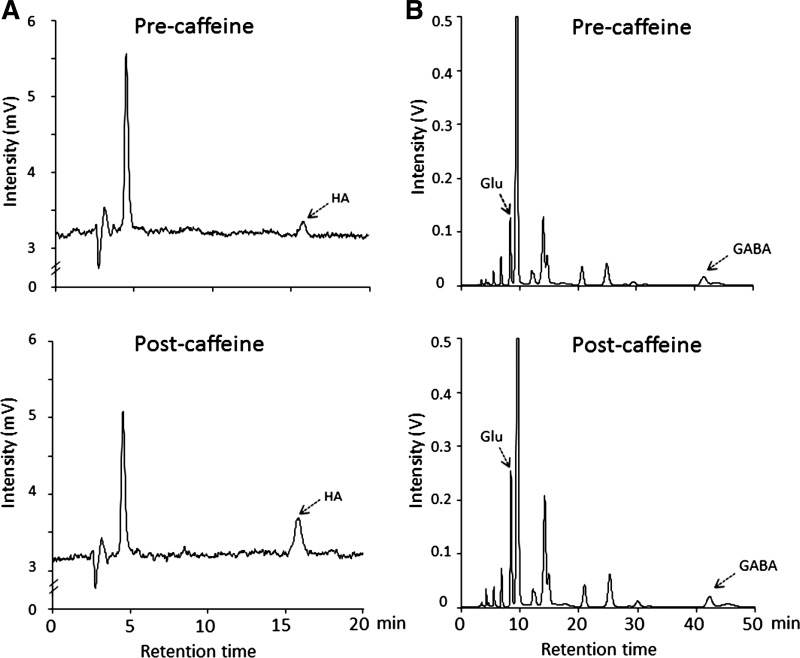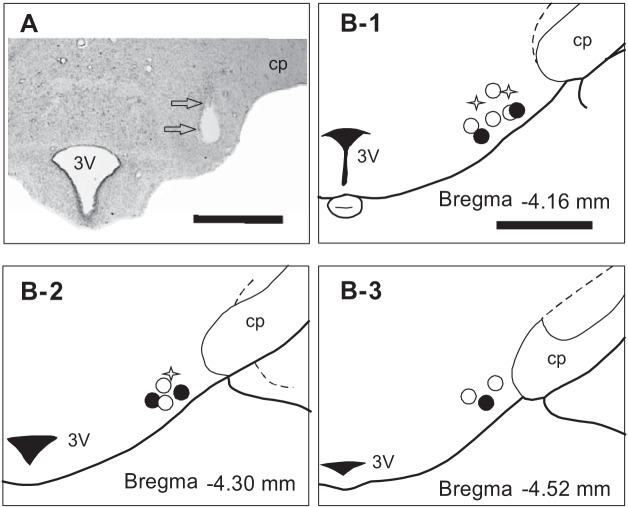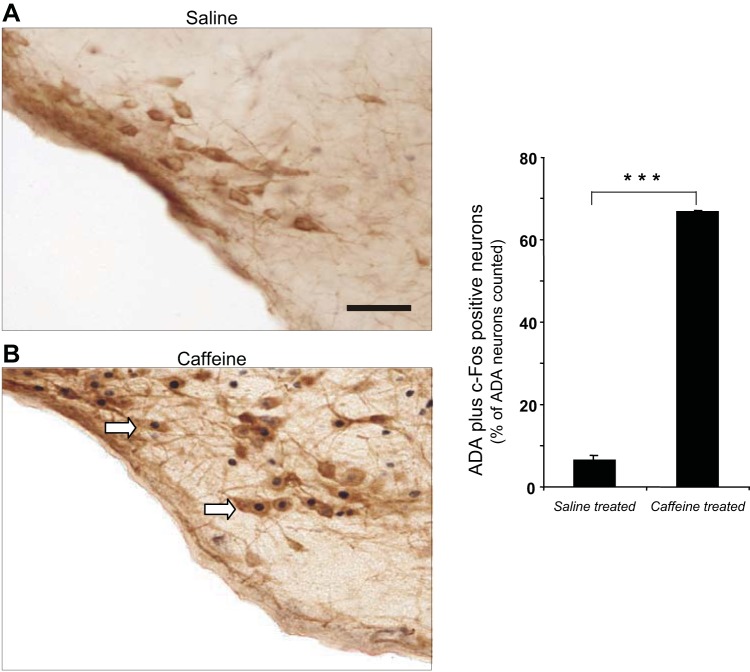Abstract
Histamine neurons are active during waking and largely inactive during sleep, with minimal activity during rapid-eye movement (REM) sleep. Caffeine, the most widely used stimulant, causes a significant increase of sleep onset latency in rats and humans. We hypothesized that caffeine increases glutamate release in the posterior hypothalamus (PH) and produces increased activity of wake-active histamine neurons. Using in vivo microdialysis, we collected samples from the PH after caffeine administration in freely behaving rats. HPLC analysis and biosensor measurements showed a significant increase in glutamate levels beginning 30 min after caffeine administration. Glutamate levels remained elevated for at least 140 min. GABA levels did not significantly change over the same time period. Histamine level significantly increased beginning 30 min after caffeine administration and remained elevated for at least 140 min. Immunostaining showed a significantly elevated number of c-Fos-labeled histamine neurons in caffeine-treated rats compared with saline-treated animals. We conclude that increased glutamate levels in the PH activate histamine neurons and contribute to caffeine-induced waking and alertness.
Keywords: microdialysis, sleep, histamine, glutamate, caffeine
caffeine (1,3,7-trimethylxanthine) is the most widely used waking stimulant. It produces an increase in waking and locomotor activity in rats (38). Caffeine has been demonstrated to reverse psychomotor impairments induced by alcohol, benzodiazepines, and antihistamines (10, 24, 25, 30). Systemically administered caffeine produces c-Fos activation in wake-promoting neurons (8) and increases waking. A nonselective blockade of A1 and A2A adenosine receptors (14) mediates the wake-inducing effect of caffeine, but the “downstream” consequences of this have not been fully identified.
It has been reported that infusion of N6-cyclohexyladenosine, a selective A1-receptor agonist, into the posterior hypothalamus (PH) increases non-rapid eye movement (REM) sleep (41). Oishi et al. reported that endogenous adenosine in the tuberomammillary nucleus (TMN) suppresses the histaminergic system via the A1R to promote non-REM sleep (37). A sleep-promoting A2A receptor agonist, CGS21680, increases GABA release in the histaminergic tuberomammillary nucleus (18). We previously reported an increase of GABA release in the PH during REM sleep linked to the cessation of activity in histamine neurons (22, 35). Thus it is possible that caffeine may promote waking through reduced release of GABA in the PH.
Adenosine receptor A2A immunoreactivity is observed primarily at glutamatergic (asymmetric) synapses (17). Thus it is possible that caffeine acting through A2AR plays a prominent role in modulating glutamatergic input to various neurons (13, 17). Caffeine induces dopamine and glutamate release in the shell of the nucleus accumbens (43). Glutamate release is higher during wakefulness and is reduced during sleep in several brain regions (7, 26). We reported that glutamate level increases in the PH in waking and REM sleep but is significantly reduced during non-REM sleep (20). This suggests that caffeine may increase the level of glutamate in the PH to promote waking.
As early as 1918, based on the observation of lesions in the brains of victims of encephalitis lethergica, Von Economo reported that the PH was necessary for the maintenance of waking (45). Stimulation of the PH produces arousal and lesion produces an increase in sleep in several species (31, 33, 34). It is known that antihistamines cause sleepiness and that stimulation of histamine neurons produce arousal (2, 15, 31). We recently showed a greatly increased number of histamine neurons in PH of the brains of human narcoleptics. This suggests that histamine neurons may contribute to the etiology and symptoms of human narcolepsy (see Ref. 21 for discussion). The activity of PH histamine neurons remains high during waking and is reduced or absent in sleep states (22, 31). Histamine neuronal activity is maintained in cataplexy, an alert wake state with loss of muscle tone (22). These findings suggest that histamine cell activity is critical to the maintenance of waking.
Thus we hypothesized that increased waking and alertness, induced by caffeine, is correlated with increased glutamate levels, reduced GABA levels, and increased activity of histamine neurons in the posterior hypothalamus.
MATERIALS AND METHODS
Experiments were conducted on adult male Sprague-Dawley rats (275–350 g) in accordance with the National Research Council's “Guide for the Care and Use of Laboratory Animals.” Animal protocols were approved by the Institutional Animal Care and Use Committee (IACUC) of the Veterans Affairs Greater Los Angeles Health Care System. The rats were kept under a 12-h light-dark cycle (9:00 AM lights-on: 9:00 PM lights-off) at an ambient temperature of 24 ± 1°C, with food and water available ad libitum.
Microdialysis Experiment
Under surgical anesthesia (ketamine-xylazine, 80:10 mg/kg ip) and aseptic conditions, rats were fixed in a stereotaxic frame (Kopf Instruments, Tujunga, CA). Bilateral stainless-steel screw electrodes were placed over the frontal and parietal cortex to record the electroencephalogram (EEG). Teflon-coated multistranded stainless steel wires with 2 mm exposed at the tips (Cooner Wire, Chatsworth, CA) were placed in the dorsal neck muscles to record the electromyogram (EMG). These wires were soldered to a socket, which in turn was anchored to the skull with dental acrylic. Microdialysis guide cannulae (CMA/11, CMA/Microdialysis, Sweden) were implanted 1 mm dorsal to the target area (PH-TMN; A −4.2, L 1.7, H 8.9 mm ventral to the dura) (39).
After 7 days of postoperative recovery, rats were habituated to a rodent microdialysis bowl (Bioanalytical Systems West Lafayette, IN), and to the EEG and EMG recording cable, which was connected to a commutator (Plastics One, Roanoke, VA). The recording bowl was placed in a sound-attenuating chamber (Thermo Electron). The rats were able to move freely in the recording bowl, with food and water available ad libitum. EEG and EMG signals were recorded with a Grass Model 15, Neurodata Amplifier system (Grass Instruments, Quincy, MA) coupled with a CED 1401 plus interface and analyzed using Spike2 software (Cambridge Electronic Design, Cambridge, UK).
Sixteen hours before the start of collection, microdialysis probes with 1-mm-long membranes (CMA/11, MW 6 kDa, CMA/Microdialysis, Sweden) were placed through the previously implanted guide cannulae into the PH-TMN. Microdialysis experiments were performed between 10:00 AM and 6:00 PM (light period). The probes were continuously perfused with artificial cerebrospinal fluid (aCSF; in mM: 145 NaCl, 2.7 KCl, 1.0 MgCl2, 1.2 CaCl2, and 2.0 Na2HPO4; pH 7.4) at a flow rate of 2 μl/min using an infusion pump (EPS-64, Eicom, Kyoto, Japan). After 2 h of aCSF perfusion, microdialysis samples were collected at 10-min intervals (20 μl) in polyethylene vials maintained at 5°C using a refrigerated fraction collector (EFC-82 and EFR-82, Eicom, Japan).
After 1 wk of handling the animals, including picking them up to habituate them to the injection procedure, rats were given caffeine intraperitoneally (Caffeine; Sigma Chemical; 25 mg/kg in 1 ml of sterile saline ip). Samples were collected before and after caffeine administration. After sample collection, 5 μl of 30% methanol was added to the samples as a preservative, and samples were stored at −80°C until analysis (22, 23). The recovery rate of the microdialysis probes for histamine, glutamate, and GABA was 10–14%. Separate groups of rats were used for the histamine (n = 8), and glutamate and GABA (n = 5) microdialysis experiments. At the end of the experiment, the animals were anesthetized and perfused with normal saline followed by formalin. Sections were Nissl stained to locate the site of the microdialysis probe.
HPLC assay of GABA, Glutamate, and Histamine
The concentrations of GABA, glutamate, and histamine in the dialysate were measured by HPLC (EP-300, Eicom, Kyoto, Japan) with fluorescent detection (Soma S-3350: excitation/emission = 340/440 nm), as described in our prior studies (23). The samples were injected using an autoinjector (ESA 540, ESA).
GABA and glutamate.
Precolumn derivatization was performed with o-phthaldialdehyde/2-mercaptoethanol at 5°C for 3 min. The derivatives were then separated in a liquid chromatography column (MA-5ODS, 2.1 × 150 mm, Eicom, Japan) at 30°C with 30% methanol in 0.1 M phosphate buffer (pH 6.0) after being degassed (DG-100, Eicom, Kyoto, Japan).
Histamine.
The mobile phase was 0.16 M KH2PO4 containing 50 mg/l octansulphonate (SOS) with a flow rate of 0.3 ml/min. Perfusates were separated in a C-18 column (SC-5ODS, 3.0 mm × 100) and then subjected to reaction with a mixture of 2.5 M NaOH (0.06 ml/min) and 0.05% OPA solution (0.06 ml/min) in a Teflon coil (0.15 mm × 5 m) at 42°C followed by mixture with 2 M H3PO (0.13 ml/min) in another reaction coil (0.15 mm × 3 m). Quantification was achieved with a PowerChrom analysis system (AD Instruments) using external amino acid standards (Sigma).
Neurotransmitter concentrations were calculated by comparing the HPLC peak of glutamate, GABA, and histamine in the microdialysis samples with peak areas of known concentrations of standards, analyzed on the same day. The detection limit for GABA, glutamate, and histamine is 20 fmol each, as in our previous studies (22, 23). Because of individual variation of the microdialysis probes (variation of recovery rate, and microenvironments of dialysis site), measurements of the absolute concentration of the neurotransmitter in any brain region may not be meaningful. So we compared the levels of neurotransmitters in the PH-TMN across experimental conditions.
Glutamate Sensor Experiment
In addition to the microdialysis assay for glutamate release, we used a glutamate sensor (Pinnacle Technology) in a separate group of rats (n = 3) to measure the release of glutamate in the PH-TMN with a higher temporal resolution (20). The glutamate sensor is an enzyme-based biosensor designed for the measurement of rapid changes in the extracellular concentrations of brain glutamate level in freely behaving rats. Two hours after the implantation of the sensor, basal sensor level (PAL software, Pinnacle Technology) was recorded for 1 h (20). Changes in glutamate level in PH-TMN was monitored for 2.5 h after caffeine administration (25 mg/kg ip).
Immunostaining of Adenosine Deaminase and c-Fos
After 1 wk of handling, a separate group of rats was given caffeine intraperitoneally (25 mg/kg in 1 ml of sterile saline, n = 4) at 12:00 PM. A control group was similarly handled and received an equal volume of saline (n = 3). Ninety minutes after caffeine or saline administration, animals were deeply anesthetized (pentobarbital sodium, 100 mg/kg ip) and transcardially perfused with 0.1 M PBS. The brain tissue obtained from experimental and control animals was processed together (at least two animals per batch) for immunostaining. Brain sections were cut at 30 μm on a freezing microtome. Alternate sections were immunostained for c-Fos and adenosine deaminase (ADA), a marker of HA neurons in rat.
Free-floating sections were incubated in 0.3% H2O2 in PBS at room temperature for 30 min. After three washes, sections were placed in blocking solution (4% goat serum and 0.2% triton in PBS) for 2 h followed by incubation with rabbit anti-c-Fos antibody (1:20,000; catalog no. PC38, Oncogene) for 48 h at 4°C. After being rinsed, sections were incubated with biotinylated goat anti-rabbit IgG (1:800; Vector Lab) for 2 h at 4°C. Further incubation with avidin-biotin complex (1:500 Vector Elite Kit) was performed for the next 2 h. Sections were developed with nickel-3,3′-diaminobenzidine tetrahydrochloride. Staining for c-Fos (black) is confined to the nucleus.
After staining for c-Fos, these sections were processed for ADA. Sections were incubated in blocking solution (4% donkey serum and 0.2% Triton in PBS) for 2 h. After being rinsed, sections were incubated in rabbit-anti-ADA antibody (ADA 1:2,000; catalog no. AB176, Chemicon) for 48 h at 4°C. They were then incubated in donkey anti-rabbit IgG (HRP) (1:200; Jackson Lab) for 2 h. Sections were developed in 3,3′-diaminobenzidine tetrahydrochloride to produce a brown reaction product. As a control, sections were processed while omitting the primary antibody or by staining after primary antibody preabsorption. Mapping of ADA-IR, c-Fos, and double-stained neurons within the TMN sections was done with the help of a Neurolucida Imaging System (Microbrightfield, Colchester, VT).
Statistical analyses of data.
A one-way ANOVA was used to compare levels of each neurotransmitter (GABA, glutamate, histamine) at various time ponts after caffeine administration. This was followed by post hoc comparisons with Fisher's least signficant difference (LSD) test. The Student's t-test (unpaired) was used to compare c-Fos expression in histamine neurons in caffeine-treated animals with saline-treated animals. The Student's t-test (paired) was used to compare sleep-wake changes before and after caffeine treatment. All values are expressed as means ± SE.
RESULTS
Changes in Glutamate and GABA Level After Caffeine Administration
There was an increase in glutamate levels in microdialysate samples collected from the posterior hypothalamus (Fig. 1). A significant 26% increase in glutamate level was observed within 30 min of caffeine administration compared with baseline (P < 0.01, Fisher's LSD; Fig. 1A). The increase was maintained for >120 min [F(4,25) = 10.9, P < 0.0001, ANOVA; Fig. 1A]. The enzymatic glutamate biosensor recording also showed that glutamate levels remained elevated compared with prior spontaneous active waking for >2 h (as in the microdialysis samples). The time course of this change can be seen in Fig. 1B. The sensor data provided data on the time course at a second-by-second level of temporal resolution compared with the 10-min resolution of the microdialysis samples. The consistency of the data from these two very different techniques strengthens our findings. In contrast to glutamate, GABA levels did not show any significant change [F(4,25) = 0.40, P > 0.05, ANOVA] after caffeine injection (Fig. 2).
Fig. 1.
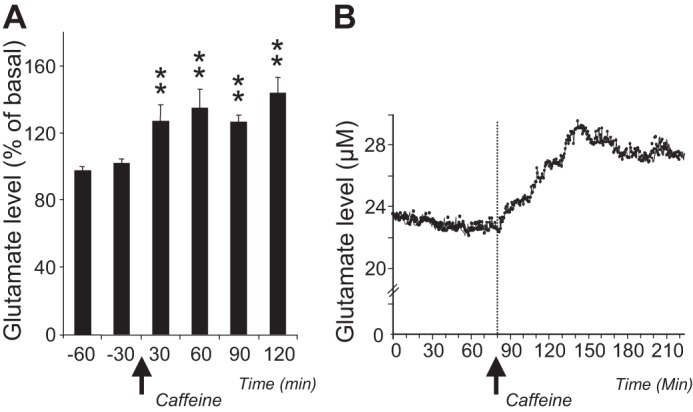
A: microdialysis-HPLC assay of glutamate level (means ± SE) in the posterior hypothalamus after systemic administration of caffeine. Samples were collected from 60 min before to 120 min after caffeine administration (n = 5). **Significant difference (P < 0.01). B: glutamate sensor recording showing the time course of the increase in glutamate level in the posterior hypothalamus after caffeine administration. The effect lasts for >2 h.
Fig. 2.
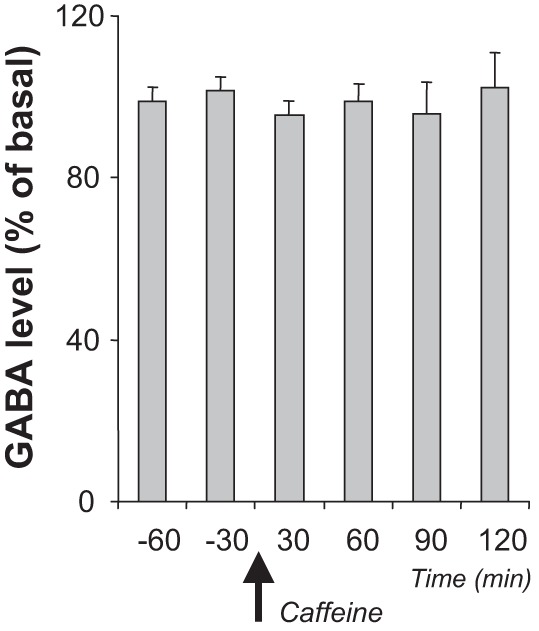
Microdialysis-HPLC assay of GABA level (means ± SE) in the posterior hypothalamus after systemic administration of caffeine. There was no statistically significant change in GABA level after caffeine administration (n = 5).
Changes in Histamine Level After Caffeine Administration
Histamine levels in the PH-TMN increased significantly after caffeine administration [F(7,192) = 3.9, P < 0.0001, ANOVA; Fig. 3]. Histamine levels increased by >80% 30 min post-caffeine injection compared with basal levels (P < 0.01, Fisher's LSD; Fig. 3). Histamine levels remained significantly elevated for >2 h post-injection (P < 0.01, Fisher's LSD).
Fig. 3.
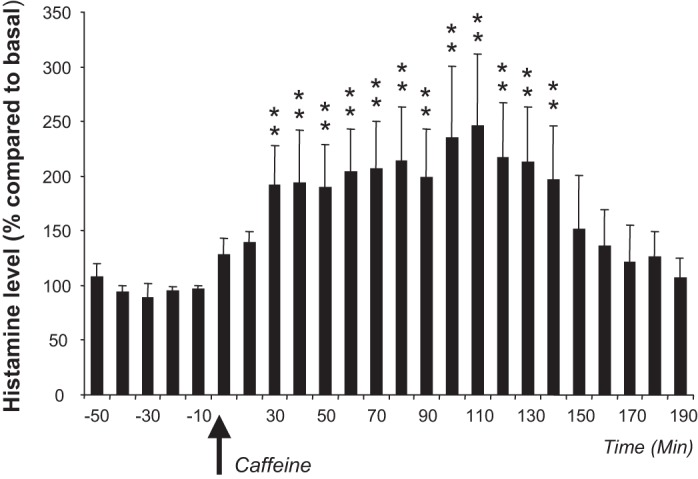
Microdialysis-HPLC assay of histamine level (means ± SE) in the posterior hypothalamus after systemic administration of caffeine (n = 8). Samples were collected from 50 min before to 190 min after caffeine administration. **Significant difference (P < 0.01).
A chromatogram of changes in glutamate and histamine peaks before and after caffeine treatment is shown in Fig. 4. Cresyl violet staining confirmed the site of the microdialysis probe in the PH (Fig. 5).
Fig. 4.
Representative chromatogram of HPLC assay showing histamine (A), and glutamate and GABA (B) peaks from microdialysis samples pre- and post-systemic administration of caffeine. HA, histamine; Glu, glutamate.
Fig. 5.
Histological illustrations showing the location of the microdialysis probe and the sensor in the posterior hypothalamus. A: a photomicrograph of the coronal section of the posterior hypothalamus showing the location of the microdialysis probe (indicated by arrows). B: location of microdialysis probe and glutamate sensor in three stereotaxic planes of rat brain through the posterior hypothalamus tuberomammillary nucleus (B1–3). The location of the tip of the microdialysis probe in animals for histamine (○) and glutamate-GABA (●) experiments; and glutamate sensor (stars). Scale bar = 1 mm. Scale bar in B-1 is same for B-2 and B-3. 3V, third ventricle mammillary recess; cp, cerebral peduncle.
Animals were handled, including picking them up to habituate them to the injection procedure, for 1 wk before caffeine administration. No saline was administered in the microdialysis comparison condition. Even though our earlier study did not observe any neurotransmitter changes after saline administration (23), the effect of handling stress with caffeine administration in the current microdialysis study cannot completely be ruled out.
Activation of Histamine Neurons After Caffeine Administration
We used c-Fos expression to determine the changes in histamine cell activation induced by caffeine. Caffeine-treated animals showed increased numbers of ADA/c-Fos double-labeled neurons in all histamine subnuclei compared with saline-treated control rats. Sixty-six percent of ADA-positive PH neurons stained for c-Fos in caffeine-treated animals. Only 6.5% of ADA-positive neurons in saline controls were c-Fos positive (t = 49.4, df 5, P < 0.0001, t-test; Fig. 6). We counted an average of 1,780 ± 140 histamine neurons (ADA-IR) from bilateral sections of PH-TMN from each animal.
Fig. 6.
The posterior hypothalamus tuberomammillary nucleus (PH-TMN) showing double immunostaining of adenosine deaminase (ADA) and c-Fos. Caffeine-treated animals (B) showed an increase in the number of histamine (ADA) and c-Fos double-labeled neurons (indicated by arrows) compared with saline-treated controls (A). Left: the number of ADA plus c-Fos positive neurons is significantly higher in caffeine-treated animals (n = 4) compared with saline-treated controls (n = 3). All data are means ± SE. Scale bar = 60 μm. ***Significant difference by t-test (P < 0.0001).
Sleep-Wake Changes After Caffeine Administration
Caffeine administration produced a large increase in waking, as reported in earlier studies (8, 10, 38). Waking was significantly (t = 8.9, df 7, P < 0.0001, t-test) higher for 2 h post-caffeine administration (99.5 ± 0.32% waking) compared with the comparable pre-caffeine period (30.8 ± 7.7% waking).
DISCUSSION
Role of Glutamate in Caffeine-Induced Waking
The PH glutamate level remained elevated for >2 h after systemic administration of caffeine compared with prior spontaneous active waking (Fig. 1). An earlier report suggested that a functional mGluR5/A2AR interaction may overcome the tonic inhibitory effect of adenosine on A2AR-containing cells (12, 13, 17). An earlier study reported the expression of A2A mRNA in the hypothalamus (9). The caffeine-induced increase in glutamate level along with a possible interaction of glutamate and A2A receptors may be important for the effect of caffeine on waking systems. We have reported high glutamate levels in the PH-TMN and cortex measured with glutamate biosensors during both AW and REM sleep compared with non-REM sleep (20).
The PH receives glutamatergic afferent projections from prefrontal cortex, lateral preoptic area, and lateral hypothalamus (5, 11). Hypocretin (Hcrt) neurons densely innervate the soma and proximal dendrites of histamine neurons, and Hcrt axon terminals are co-localized with glutamate (44). Hcrt exerts its wake-promoting effect through the histaminergic system (19), and glutamate would be expected to contribute to the wake-promoting effect of Hcrt (28). We speculate that multiple sources may contribute to the increased glutamate level in the PH, but their relative contributions are unknown. The PH-TMN receives afferent projections from monoaminergic inputs, originating from the adrenergic, noradrenergic, and serotonergic cell groups of various brain regions (31). Glutamate may also modulate the activity of histamine neurons through its interaction with these wake-related monoaminergic systems (20). Simultaneous saporin-induced lesions of the wake-related histamine acetylcholine and norepinephrine-containing neurons have little effect on the duration of waking (3). We hypothesize that widespread glutamate release may play a role in maintaining arousal, even in the absence of various arousal-related neuronal populations (3, 7, 20).
Role of GABA in Caffeine-Induced Waking
PH neurons receive strong GABAergic inputs from the diagonal band of Broca, lateral hypothalamus, and the preoptic and ventrolateral preoptic regions (40, 42, 47). However, in contrast to glutamate, we did not see any significant change in GABA levels in the PH after caffeine administration. It appears that the large increase in glutamate levels, rather than a decrease in GABA release, is linked to the increased arousal after caffeine administration.
Role of Histamine in Caffeine-Induced Waking and Alertness
An earlier study by Deurveilher et al. reported that a low dose (10 mg/kg) of caffeine increased c-Fos activation of histamine neurons, but other doses of caffeine (30 and 100 mg/kg) did not produce activation (8). Double immunostaining for adenosine deaminase and c-Fos in our current study showed that activation of histamine neurons was significantly higher in caffeine-treated animals compared with saline controls. We used only one dose of caffeine (25 mg/kg), which is lower than the doses Deurveilher et al. used in the study that showed no caffeine response. However, our study shows that a low dose of caffeine may be suitable for the activation of histamine neurons.
Histamine maintains wakefulness through direct projections of PH-histamine neurons to the thalamus and the cortex, and indirectly through activation of other ascending arousal systems, mainly cholinergic and aminergic systems (16). Histamine neurons co-express NMDA receptor NR1 with NR2A and NR2B subunits (12). A microdialysis study showed that NMDA receptor activation increases histamine release in the anterior hypothalamus (36). This suggests that glutamate enhances histamine release through NMDA receptors located on histaminergic nerve terminals. Moreover, there is a tonic glutamatergic regulation of this release (36).
We showed that, in canine narcolepsy, activity of histamine neurons is high during waking and cataplexy, and is reduced or absent during sleep (22). Norepinephrine-containing cells in the locus coeruleus, on the other hand, fall silent during cataplexy, an alert wake state (46). The divergent patterns of discharge of these REM sleep-off cell groups in cataplexy supports the concept that activity of histamine cell groups is strongly linked to forebrain arousal, whereas serotonergic and noradrenergic neuron cells have roles in the coordination of motor activity with forebarin arousal (22). Our current findings of increased histamine neuronal activation and release of histamine after caffeine administration suggest that these neurons play an important role in caffeine-induced arousal and alertness.
Other Transmitters
Earlier studies have shown that caffeine produces an increase in dopamine and acetylcholine levels in the prefrontal cortex (1). Lazarus et al. (29) reported that the A2A receptors in the shell region of the nucleus accumbens are critical for the effect of caffeine on wakefulness. A report by Deurveilher et al. (8) showed that caffeine induced distinct dose-related patterns of c-Fos immunoreactivity in several wake-promoting neuronal populations, including orexin neurons, non-orexin and non-melanin-concentrating hormone neurons in the lateral hypothalamus, histaminergic neurons, noradrenergic neurons, noncholinergic basal forebrain neurons that do not contain parvalbumin, and non-dopaminergic neurons in the ventral tegmental area. However, caffeine induced little or no c-Fos expression in cholinergic neurons of the basal forebrain and serotonergic neurons in the dorsal raphe nucleus. Caffeine did not activate melanin-concentrating hormone (MCH) neurons, which play a critical role the control of sleep (4, 8, 27). The lack of Fos expression cannot be taken as an indication that these cell groups were not activated, since not all cell groups express Fos equally when active (6, 32).
It is likely that neurotransmitters, other than histamine, also contribute to the arousal effects of caffeine. Although the results in this study show a strong correlation between glutamate and histamine activation and release, the two processes may not be directly coupled. It has been reported that A1R are expressed on histamine neurons of the rat TMN (37), thus caffeine may disinhibit the tonic effects of adenosine on TMN neurons, resulting in activation and release of histamine.
Perspectives and Significance
This study provides evidence for increased release of histamine and glutamate in caffeine-induced arousal and alertness. Our earlier report suggests that histamine cell activity is critical to the maintenance of waking and alertness during cataplexy in canine narcoleptics. Our present report provides further evidence for a critical role of histamine and glutamate in arousal.
GRANTS
This study was supported by the Medical Research Service of the Dept. of Veterans Affairs, and National Institutes of Health Grants NS-14610 and MH-064109.
DISCLOSURES
No conflicts of interest, financial or otherwise, are declared by the author(s).
AUTHOR CONTRIBUTIONS
Author contributions: J.J. and J.M.S. conception and design of research; J.J. performed experiments; J.J. and T.K. analyzed data; J.J. and J.M.S. interpreted results of experiments; J.J. prepared figures; J.J. and J.M.S. drafted manuscript; J.J. and J.M.S. edited and revised manuscript; J.J., T.K., and J.M.S. approved final version of manuscript.
REFERENCES
- 1.Acquas E, Tanda G, Di Chiara G. Differential effects of caffeine on dopamine and acetylcholine transmission in brain areas of drug-naive and caffeine-pretreated rats. Neuropsychopharmacology 27: 182–193, 2002 [DOI] [PubMed] [Google Scholar]
- 2.Bender BG, Berning S, Dudden R, Milgrom H, Tran ZV. Sedation and performance impairment of diphenhydramine and second-generation antihistamines: a meta-analysis. J Allergy Clin Immunol 111: 770–776, 2003 [DOI] [PubMed] [Google Scholar]
- 3.Blanco-Centurion C, Gerashchenko D, Shiromani PJ. Effects of saporin-induced lesions of three arousal populations on daily levels of sleep and wake. J Neurosci 27: 14041–14048, 2007 [DOI] [PMC free article] [PubMed] [Google Scholar]
- 4.Blouin AM, Fried I, Wilson CL, Staba RJ, Behnke EJ, Lam HA, Maidment NT, Karlsson KÆ, Lapierre JL, Siegel JM. Human hypocretin and melanin-concentrating hormone levels are linked to emotion and social interaction. Nat Commun 4: 1547, 2013 [DOI] [PMC free article] [PubMed] [Google Scholar]
- 5.Brown RE, Stevens DR, Haas HL. The physiology of brain histamine. Prog Neurobiol 63: 637–672, 2001 [DOI] [PubMed] [Google Scholar]
- 6.Cirelli C, Tononi G. On the functional significance of c-fos induction during the sleep-waking cycle. Sleep 23: 9–25, 2000 [PubMed] [Google Scholar]
- 7.Dash MB, Douglas CL, Vyazovskiy VV, Cirelli C, Tononi G. Long-term homeostasis of extracellular glutamate in the rat cerebral cortex across sleep and waking states. J Neurosci 29: 620–629, 2009 [DOI] [PMC free article] [PubMed] [Google Scholar]
- 8.Deurveilher S, Lo H, Murphy JA, Burns J, Semba K. Differential c-Fos immunoreactivity in arousal-promoting cell groups following systemic administration of caffeine in rats. J Comp Neurol 498: 667–689, 2006 [DOI] [PubMed] [Google Scholar]
- 9.Dixon AK, Gubitz AK, Sirinathsinghji DJS, Richardson PJ, Freeman TC. Tissue distribution of adenosine receptor mRNAs in the rat. Br J Pharmacol 118: 1461–1468, 1996 [DOI] [PMC free article] [PubMed] [Google Scholar]
- 10.Drake CL, Roehrs T, Turner L, Scofield HM, Roth T. Caffeine reversal of ethanol effects on the multiple sleep latency test, memory, and psychomotor performance. Neuropsychopharmacology 28: 371–378, 2003 [DOI] [PubMed] [Google Scholar]
- 11.Ericson H, Blomqvist A, Kohler C. Origin of neuronal inputs to the region of the tuberomammillary nucleus of the rat brain. J Comp Neurol 311: 45–64, 1991 [DOI] [PubMed] [Google Scholar]
- 12.Faucard R, Armand V, Héron A, Cochois V, Schwartz JC, Arrang JM. N-methyl-d-aspartate receptor antagonists enhance histamine neuron activity in rodent brain. J Neurochem 98: 1487–1496, 2006 [DOI] [PubMed] [Google Scholar]
- 13.Ferré S, Karcz-Kubicha M, Hope BT, Popoli P, Burgueño J, Gutiérrez MA, Casadó V, Fuxe K, Goldberg SR, Lluis C, Franco R, Ciruela F. Synergistic interaction between adenosine A2A and glutamate mGlu5 receptors: implications for striatal neuronal function. Proc Natl Acad Sci USA 99: 11940–11945, 2002 [DOI] [PMC free article] [PubMed] [Google Scholar]
- 14.Fredholm BB. Adenosine, adenosine receptors and the actions of caffeine. Pharmacol Toxicol 76: 93–101, 1995 [DOI] [PubMed] [Google Scholar]
- 15.Guilleminault C, Anognos A. Narcolepsy. In: Principles and Practice of Sleep Medicine (3rd ed.), edited by Dement WC. Philadelphia, PA: Saunders, 2000, p. 676–686 [Google Scholar]
- 16.Haas HL, Sergeeva OA, Selbach Histamine in the nervous system. Physiol Rev 88: 1183, 2008 [DOI] [PubMed] [Google Scholar]
- 17.Hettinger BD, Lee A, Linden J, Rosin DL. Ultrastructural localization of adenosine A2A receptors suggests multiple cellular sites for modulation of GABAergic neurons in rat striatum. J Comp Neurol 431: 331–346, 2001 [DOI] [PubMed] [Google Scholar]
- 18.Hong ZY, Huang ZL, Qu WM, Eguchi N, Urade Y, Hayaishi O. An adenosine A receptor agonist induces sleep by increasing GABA release in the tuberomammillary nucleus to inhibit histaminergic systems in rats. J Neurochem 92: 1542–1549, 2005 [DOI] [PubMed] [Google Scholar]
- 19.Huang ZL, Qu WM, Li WD, Mochizuki T, Eguchi N, Watanabe T, Urade Y, Hayaishi O. Arousal effect of orexin A depends on activation of the histaminergic system. Proc Natl Acad Sci USA 98: 9965–9970, 2001 [DOI] [PMC free article] [PubMed] [Google Scholar]
- 20.John J, Ramanathan L, Siegel JM. Rapid changes in glutamate levels in the posterior hypothalamus across sleep-wake states in freely behaving rats. Am J Physiol Regul Integr Comp Physiol 295: R2041–R2049, 2008 [DOI] [PMC free article] [PubMed] [Google Scholar]
- 21.John J, Thannickal TC, McGregor R, Ramanathan L, Ohtsu H, Nishino S, Sakai N, Yamanaka A, Stone C, Cornford M, Siegel JM. Greatly increased numbers of histamine cells in human narcolepsy with cataplexy. Ann Neurol 74: 786–793, 2013 [DOI] [PMC free article] [PubMed] [Google Scholar]
- 22.John J, Wu MF, Boehmer LN, Siegel JM. Cataplexy-active neurons in the hypothalamus: implications for the role of histamine in sleep and waking behavior. Neuron 42: 619–634, 2004 [DOI] [PMC free article] [PubMed] [Google Scholar]
- 23.John J, Wu MF, Kodama T, Siegel JM. Intravenously administered hypocretin-1 alters brain amino acid release: an in vivo microdialysis study in rats. J Physiol 548: 557–562, 2003 [DOI] [PMC free article] [PubMed] [Google Scholar]
- 24.Johnson LC, Spinweber CL, Gomez SA. Benzodiazepines and caffeine: effect on daytime sleepiness, performance, and mood. Psychopharmacology (Berl) 101: 160–167, 1990 [DOI] [PubMed] [Google Scholar]
- 25.Kim SW, Bae KY, Shin HY, Kim JM, Shin IS, Kim JK, Kang G, Yoon JS. Caffeine counteracts impairments in task-oriented psychomotor performance induced by chlorpheniramine: a double-blind placebo-controlled crossover study. J Psychopharmacol (Oxf) 27: 62–70, 2013 [DOI] [PubMed] [Google Scholar]
- 26.Kodama T, Honda Y. Acetylcholine and glutamate release during sleep-wakefulness in the pedunculopontine tegmental nucleus and norepinephrine changes regulated by nitric oxide. Psychiatry Clin Neurosci 53: 109–111, 1999 [DOI] [PubMed] [Google Scholar]
- 27.Konadhode RR, Pelluru D, Blanco-Centurion C, Zayachkivsky A, Liu M, Uhde T, Glen WB, Jr, van den Pol AN, Mulholland PJ, Shiromani PJ. Optogenetic stimulation of MCH neurons increases sleep. J Neurosci 33: 10257–10263, 2013 [DOI] [PMC free article] [PubMed] [Google Scholar]
- 28.Kostin A, Siegel JM, Alam MN. Lack of hypocretin signaling attenuates behavioral changes produced by glutamatergic activation of the perifornical-lateral hypothalamic area. Sleep 37: 1011–1020, 2014 [DOI] [PMC free article] [PubMed] [Google Scholar]
- 29.Lazarus M, Shen HY, Cherasse Y, Qu WM, Huang ZL, Bass CE, Winsky-Sommerer R, Semba K, Fredholm BB, Boison D, Hayaishi O, Urade Y, Chen JF. Arousal effect of caffeine depends on adenosine A2A receptors in the shell of the nucleus accumbens. J Neurosci 31: 10067–10075, 2011 [DOI] [PMC free article] [PubMed] [Google Scholar]
- 30.Liguori A, Robinson JH. Caffeine antagonism of alcohol induced driving impairment. Drug Alcohol Depend 63: 123–129, 2001 [DOI] [PubMed] [Google Scholar]
- 31.Lin JS. Brain structures and mechanisms involved in the control of cortical activation and wakefulness, with emphasis on the posterior hypothalamus and histaminergic neurons. Sleep Med Rev 4: 471–503, 2000 [DOI] [PubMed] [Google Scholar]
- 32.Lin JS, Hou Y, Jouvet M. Potential brain neuronal targets for amphetamine-, methylphenidate-, and modafinil-induced wakefulness, evidenced by c-fos immunocytochemistry in the cat. Proc Natl Acad Sci USA 93: -R14128–14133, 1996 [DOI] [PMC free article] [PubMed] [Google Scholar]
- 33.Lin JS, Sakai K, Vanni-Mercier G, Jouvet M. A critical role of the posterior hypothalamus in the mechanisms of wakefulness determined by microinjection of muscimol in freely moving cats. Brain Res 479: 225–240, 1989 [DOI] [PubMed] [Google Scholar]
- 34.McGinty DJ. Somnolence, recovery and hyposomnia following ventro-medial diencephalic lesions in the rat. Electroencephalogr Clin Neurophysiol 26: 70–79, 1969 [DOI] [PubMed] [Google Scholar]
- 35.Nitz D, Siegel JM. GABA release in posterior hypothalamus across sleep-wake cycle. Am J Physiol Regul Integr Comp Physiol 271: R1707–R1712, 1996 [DOI] [PMC free article] [PubMed] [Google Scholar]
- 36.Okakura K, Yamatodani A, Mochizuki T, Horii A, Wada H. Glutamatergic regulation of histamine release from rat hypothalamus. Eur J Pharmacol 213: 189–192, 1992 [DOI] [PubMed] [Google Scholar]
- 37.Oishi Y, Huang ZL, Fredholm BB, Urade Y, Hayaishi O. Adenosine in the tuberomammillary nucleus inhibits the histaminergic system via A1 receptors and promotes non-rapid eye movement sleep. Proc Natl Acad Sci USA 105: 19992–19997, 2008 [DOI] [PMC free article] [PubMed] [Google Scholar]
- 38.Paterson LM, Wilson SJ, Nutt DJ, Hutson PH, Ivarsson M. Characterisation of the effects of caffeine on sleep in the rat: a potential model of sleep disruption. J Psychopharmacol (Oxf) 23: 475–486, 2009 [DOI] [PubMed] [Google Scholar]
- 39.Paxinos G, Watson C. The Rat Brain in Stereotaxic Coordinates. San Diego, CA: Academic, 1997 [Google Scholar]
- 40.Salin-Pascual R, Gerashchenko D, Greco M, Blanco-Centurion C, Shiromani PJ. Hypothalamic regulation of sleep. Neuropsychopharmacology 25: S21–S27, 2001 [DOI] [PubMed] [Google Scholar]
- 41.Satoh S, Matsumura H, Suzuki F, Hayaishi O. Promotion of sleep mediated by the A2a-adenosine receptor and possible involvement of this receptor in the sleep induced by prostaglandin D2 in rats. Proc Natl Acad Sci USA 93: 5980–5984, 1996 [DOI] [PMC free article] [PubMed] [Google Scholar]
- 42.Sherin JE, Elmquist JK, Torrealba F, Saper CB. Innervation of histaminergic tuberomammillary neurons by GABAergic and galaninergic neurons in the ventrolateral preoptic nucleus of the rat. J Neurosci 18: 4705–4721, 1998 [DOI] [PMC free article] [PubMed] [Google Scholar]
- 43.Solinas M, Ferré S, You ZB, Karcz-Kubicha M, Popoli P, Goldberg SR. Caffeine induces dopamine and glutamate release in the shell of the nucleus accumbens. J Neurosci 22: 6321–6324, 2002 [DOI] [PMC free article] [PubMed] [Google Scholar]
- 44.Torrealba F, Yanagisawa M, Saper CB. Colocalization of orexin and glutamate immunoreactivity in axon terminals in the tuberomammillary nucleus in rats. Neuroscience 119: 1033–1044, 2003 [DOI] [PubMed] [Google Scholar]
- 45.von Economo C. Sleep as a problem of localization. J Nerv Met Dis 71: 249–259, 1930 [Google Scholar]
- 46.Wu MF, Gulyani SA, Yau E, Mignot E, Phan B, Siegel JM. Locus coeruleus neurons: cessation of activity during cataplexy. Neuroscience 91: 1389–1399, 1999 [DOI] [PMC free article] [PubMed] [Google Scholar]
- 47.Yang QZ, Hatton GI. Electrophysiology of excitatory and inhibitory afferents to rat histaminergic tuberomammillary nucleus neurons from hypothalamic and forebrain sites. Brain Res 773: 162–172, 1997 [DOI] [PubMed] [Google Scholar]



